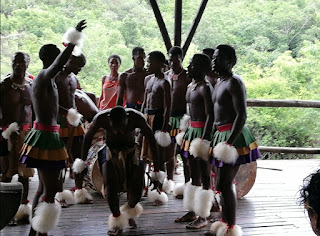Day 2 Boat cruise on the Blyderivier dam
Blyde dam boat trip allows you to enjoy the natural beauty of this spectacular Canyon from below. The 90 minute interpretation tour take you to the you to the rare living Kadishi Tufa waterfall and the Three Rondawels. The Kadishi Tufa waterfall 200m (around 660 feet) in height is the second tallest tufa waterfall on earth.
The dam and surrounds is home to a range of wildlife species such as kudu and duiker, as well as leopard and other small carnivores. The dam is home to hippo’s, crocodiles, Fish Eagles and African Finfoot which you may be lucky enough to spot.
Day 3, Hike in Kruger National Park.
Enjoy this amazing walk in the wild while spotting smaller animals which is not possible from a vehicle . 🦏🐘🦒🚶♀️🚶♂️
The Kingdom is a landlocked country in South Africa. It provides travellers the ideal gateway between Kruger National Park and KwaZulu-Natal with an added advantage of discovering a whole new country offering Swazi culture, art, wildlife, lovely Nature and great outdoor activities.
The Umfolozi and Hluhluwe reserves were established primarily to protect the white rhinoceros, then on the endangered species list. The area has always been a haven for animals as tsetse flies carrying the nagana disease are common, which protected the area from hunters in the colonial era.
Beautiful park.
Day 6 Visit iSimangaliso Wetland Park which is South Africa's third-largest protected area, spanning 280 km of coastline, from the Mozambican border in the north to Mapelane south of the Lake St. Lucia estuary, and made up of around 3,280 km2 of natural ecosystems.
The word isimangaliso means "a miracle" or "something wondrous" in Zulu.
The park was proclaimed South Africas first world heritage site in 1999 because of the rich biodiversity, unique ecosystems and natural beauty occurring in a relatively small area. The reason for the huge diversity in fauna and flora is the great variety of different ecosystems on the park, ranging from coral reefs and sandy beaches to subtropical dune forests, savannas, and wetlands. The park is wonderfuly rich in bird life. Animals occurring in the park include the Big Five, and in the ocean, whales, dolphins, and marine turtles including the leatherback and loggerhead turtle.The park is also home to 1,200 Nile crocodiles and 800 hippopotami.
Day 7 Continue to the Drakensberg mountain which is renowned for its spectacular natural landscape, importance as a haven for many threatened and endemic species, and for its wealth of rock paintings made by the San people over a period of 4000 years. The Drakensberg also offers spectacular hiking trails.
The Drakensberg is the name given to the eastern portion of the Great Escarpment, which encloses the central Southern African plateau. The Great Escarpment reaches its greatest elevation – 2,000 to 3,482 metres within the border region of South Africa and Lesotho. The Maloti Drakensberg Transboundary is a World Heritage Site since 1997.
https://whc.unesco.org/en/list/985/





























































No comments:
Post a Comment